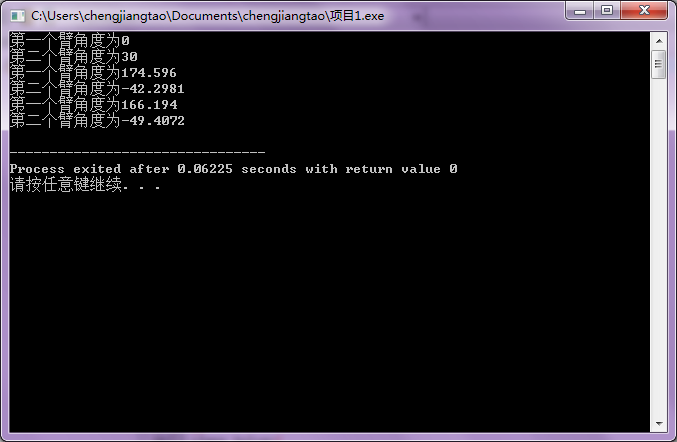#include<iostream>
#include <Eigen/Dense>
#include <math.h>
#include <vector>aa
using namespace std;
using namespace Eigen;
using Eigen::MatrixXd;
const double Pi=3.1415926;
class Frame{
private:
double Ox;
double Oy;
double Ang;
public:
Frame(){
Ox=0;Oy=0;Ang=0;
};
Frame(double ox,double oy,double ang){
Ox=ox;Oy=oy;Ang=ang*Pi/180;
};
MatrixXd transfer(){
MatrixXd trans(3,3);
trans(0,0)=cos(Ang);trans(0,1)=-sin(Ang);trans(0,2)=Ox;
trans(1,0)=sin(Ang);trans(1,1)=cos(Ang); trans(1,2)=Oy;
trans(2,0)=0; trans(2,1)=0; trans(2,2)=1;
return trans;
}
};
class Solver{
private:
vector<Frame> frameVec;
public:
MatrixXd CalTheta(double l1,double l2,Frame frame,double px,double py){
MatrixXd TF(3,1),WF(3,1),T(2,1);
TF(0,0)=px;TF(1,0)=py;TF(2,0)=1;
WF=frame.transfer()*TF;
T(0,0)=acos((px*px+py*py-l1*l1-l2*l2)/2/l1/l2);
double beta=atan2(py,px);
double lp=sqrt(px*px+py*py);
double fea=acos((lp*lp+l1*l1-l2*l2)/2/l1/lp);
T(1,0)=beta-fea;
return T;
};
void addFrame(Frame frame) {
frameVec.push_back(frame);
};
void deleteFrame(){
frameVec.pop_back();
};
};
class Robot{
public:
double L1;
double L2;
double ang1;
double ang2;
Robot(){
L1=100;L2=100;ang1=0;ang2=0;
};
Robot(double l1,double l2,double a1,double a2){
L1=l1;L2=l2;ang1=a1*Pi/180;ang2=a2*Pi/180;
};
Vector2d getang(){
MatrixXd T(2,1);
T(0,0)=L1*cos(ang1)+L2*cos(ang1+ang2);
T(1,0)=L1*sin(ang1)+L2*sin(ang1+ang2);
return T;
};;
void Output(){
cout<<"第一个臂角度为"<<ang1*180/Pi<<endl<<"第二个臂角度为"<<ang2*180/Pi<<endl;
};
void PTPmove(Frame frame,double px,double py){
Solver solver;
MatrixXd T(2,1);
T=solver. CalTheta(L1,L2,frame,px,py);
ang1=T(0,0);ang2=T(1,0);
}
};
int main(){
Robot myRobot(150,150,0,30);//构造Robot对象
Frame TF1(5,6,10),TF2(15,20,-30),TF3(23,17,90);//定义任务坐标系
myRobot.Output();
myRobot.PTPmove(TF1,10,10);
myRobot.Output();
myRobot.PTPmove(TF2,30,20);
myRobot.Output();
return 0;}
